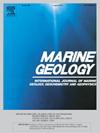Supra-subduction lithospheric metasomatism and water outflux beyond island-arc volcanism
IF 2.2
3区 地球科学
Q2 GEOSCIENCES, MULTIDISCIPLINARY
引用次数: 0
Abstract
Understanding the global water balance between subduction influx and outflux requires exploring for unrecognized sources of water outflux beyond island-arc volcanism. Here we investigate the petrogenesis of the principal high-temperature hydrous mineral (i.e., amphiboles) in oceanic gabbros of the Huatung Basin, an Early Cretaceous oceanic relict sandwiched between the Gagua Ridge Arc and the Taiwan-Luzon Arc in the northwesternmost corner of the Philippine Sea Plate. The amphiboles show low TiO2 (<1.5 wt%) and Nb/Yb (≤0.3) and ∼550–800 °C equilibration temperatures using amphibole-plagioclase thermometry, indicating high-temperature metamorphic origins. The low whole-rock 87Sr/86Sr (703216–0.703294) indicates the fluids involved in the formation of these amphiboles were hydrous island-arc melts. Viewed in conjunction with the large variations of the existed radioisotopic ages (∼130, ∼123–116, ∼105, and ∼70 Ma), the reported seismic velocity structure of the Huatung Basin that implies younger ocean lithosphere ages (20–50 Ma) is likely related to pervasive supra-subduction lithospheric metasomatism of the oceanic lithosphere. This metasomatism was probably hosted by intrusions of Gagua Ridge and Taiwan-Luzon island-arc magmatism. We suggest that such metasomatism of supra-subduction lithosphere by hydrous island-arc melts could be important for water outflux beyond island-arc volcanism globally.
超俯冲岩石圈交代作用和岛弧火山作用外的水流出
要了解俯冲内流和流出之间的全球水平衡,就需要探索岛弧火山作用之外尚未被认识的水流出来源。本文研究了菲律宾海板块西北角,夹在加瓜脊弧和台湾-吕宋弧之间的早白垩世海洋遗迹华东盆地洋辉长岩中主要高温含水矿物(角闪石)的岩石成因。角闪石-斜长石测温显示,该角闪石的TiO2 (<1.5 wt%)和Nb/Yb(≤0.3)较低,平衡温度为~ 550-800℃,表明其高温变质成因。全岩87Sr/86Sr(703216-0.703294)值较低,表明角闪孔形成流体为含水岛弧熔体。结合现有放射性同位素年龄(~ 130、~ 123-116、~ 105和~ 70 Ma)的大变化,华东盆地的地震速度结构表明海洋岩石圈年龄更年轻(20-50 Ma),这可能与海洋岩石圈普遍存在的超俯冲岩石圈交代作用有关。该交代作用可能受加瓜岭侵入和台湾-吕宋岛弧岩浆作用的支配。我们认为,这种由含水岛弧熔体形成的超俯冲岩石圈交代作用可能对全球岛弧火山作用之外的水流出具有重要意义。
本文章由计算机程序翻译,如有差异,请以英文原文为准。
求助全文
约1分钟内获得全文
求助全文
来源期刊

Marine Geology
地学-地球科学综合
CiteScore
6.10
自引率
6.90%
发文量
175
审稿时长
21.9 weeks
期刊介绍:
Marine Geology is the premier international journal on marine geological processes in the broadest sense. We seek papers that are comprehensive, interdisciplinary and synthetic that will be lasting contributions to the field. Although most papers are based on regional studies, they must demonstrate new findings of international significance. We accept papers on subjects as diverse as seafloor hydrothermal systems, beach dynamics, early diagenesis, microbiological studies in sediments, palaeoclimate studies and geophysical studies of the seabed. We encourage papers that address emerging new fields, for example the influence of anthropogenic processes on coastal/marine geology and coastal/marine geoarchaeology. We insist that the papers are concerned with the marine realm and that they deal with geology: with rocks, sediments, and physical and chemical processes affecting them. Papers should address scientific hypotheses: highly descriptive data compilations or papers that deal only with marine management and risk assessment should be submitted to other journals. Papers on laboratory or modelling studies must demonstrate direct relevance to marine processes or deposits. The primary criteria for acceptance of papers is that the science is of high quality, novel, significant, and of broad international interest.
 求助内容:
求助内容: 应助结果提醒方式:
应助结果提醒方式:


